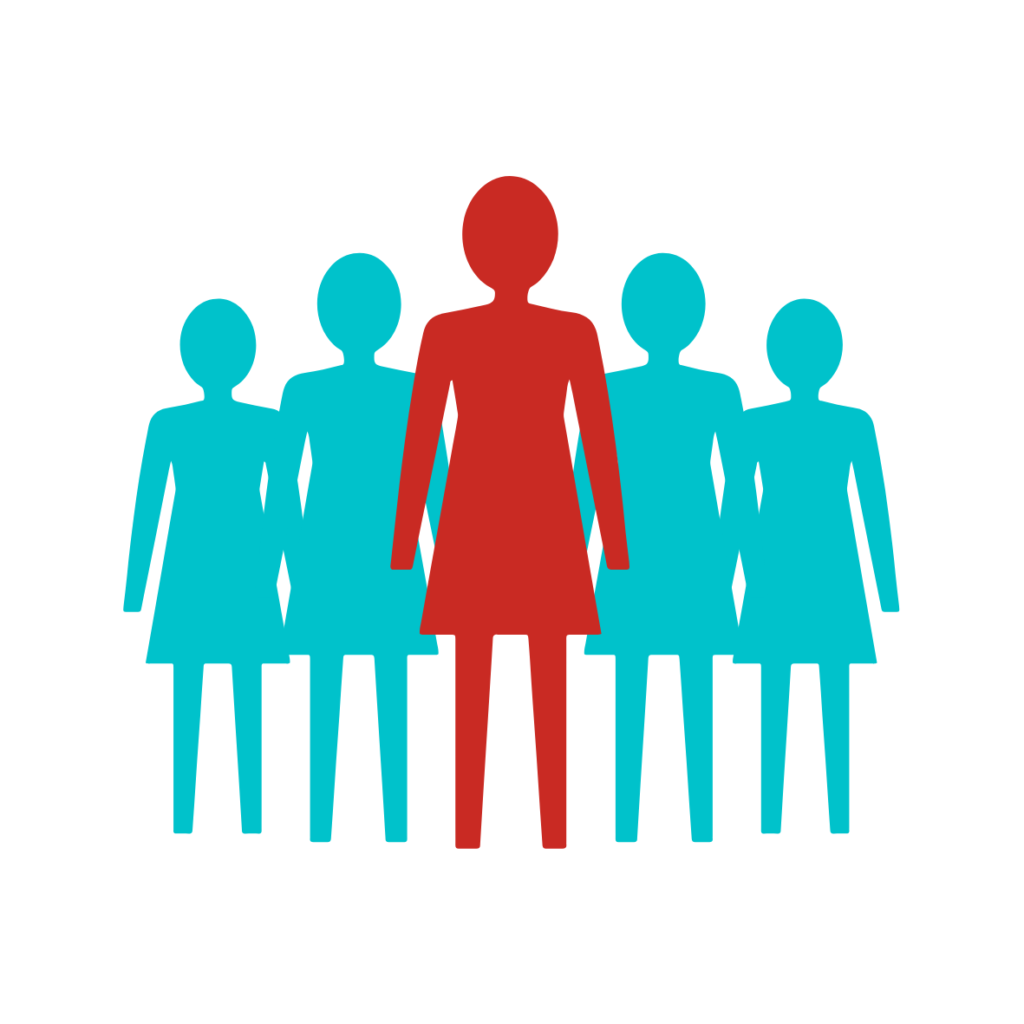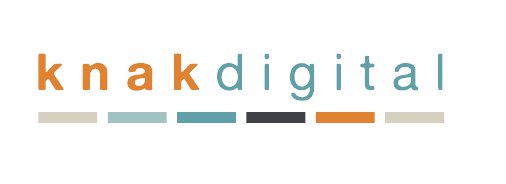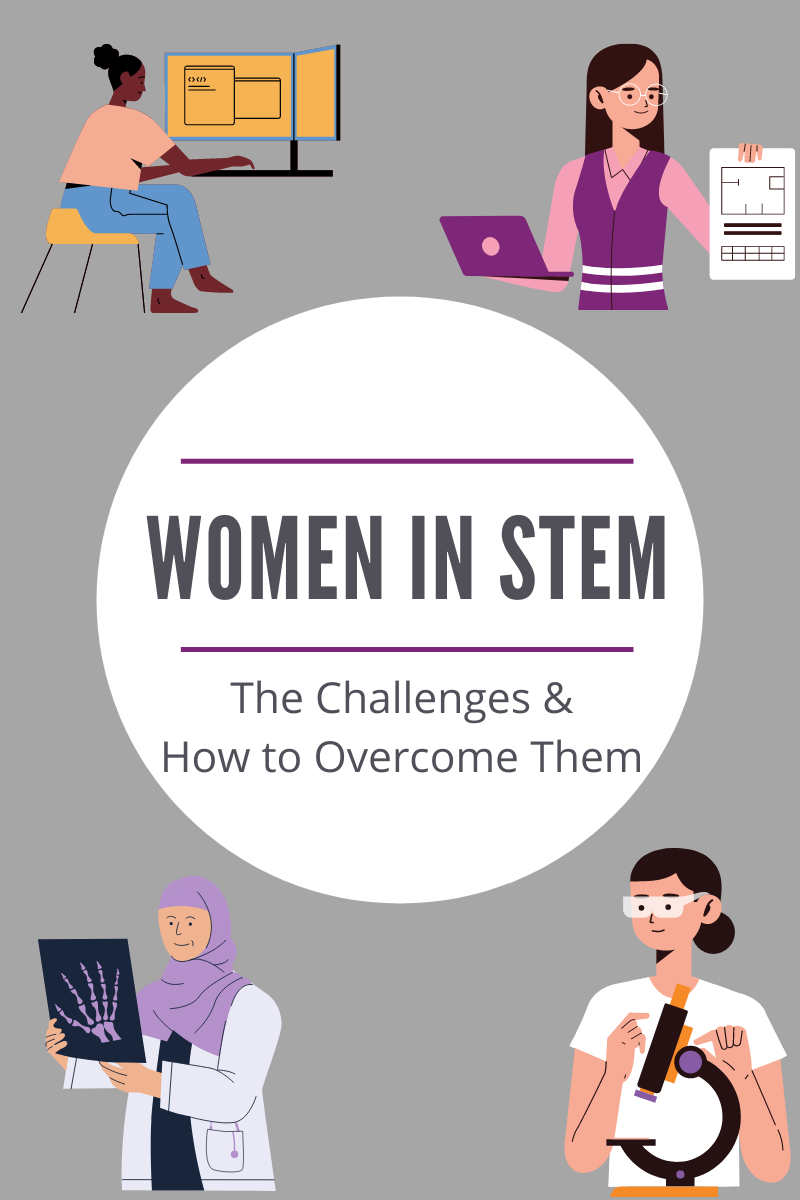Women are significantly underrepresented in the STEM (Science, Technology, Engineering, Math) career paths. This isn’t a new anomaly.
First, why is it important to intentionally build more inclusive teams with women?
- Innovation: When you hire employees that have different ideas, perspectives, and life experiences, they are able to drive innovation by offering unique solutions.
- Market Need: The demand for STEM careers are high.
- Proven Representation: More female representation in STEM will inspire and encourage younger up-and-coming generations.
- Financial Stability: STEM careers typically offer higher wages
The positive news? The intentional disruption has produced progress, slow but upward. Women pioneers like Maria Mitchell (first astronomer), Grace Hopper (Naval Officer and Programmer), and Rebecca Lee Crumpler (first African American physician) blazed the path for the amazing women to follow.
World War II had created a need for talent in STEM, as there was a shortage of civilian male employees that had been called to service. Women were encouraged to join the ranks of employment, and the Rosie the Riveter marketing campaign strived to “normalize” women in the workplace. When the war ended, some women left their careers to resume their roles as housewives.
The second wave of the women’s liberation movement started in the ’60s, with women touting a clear message of wanting equal pay and opportunity with their male counterparts. JFK signed the Equal Pay Act in 1963, to prohibit discrimination on account of gender. It didn’t abolish the practice, but it was a move in addressing gender-based pay disparities.
Strives have been made in 50 years. In 1970, women made up 38% of the workforce but only 8% of STEM workers.
By 2019, the U.S. Census Bureau reported that women made up 48% of the workforce and 27% were STEM workers.
Let’s break it down further.
What is the specific type of STEM occupations where women are represented?
A study by Pew Research Center earlier this year showed that for the women employed in STEM:
Women are over-represented in health-related jobs 🩺 (Women 74% healthcare practitioners/techs)
Women are under-represented in physical science, computer, and engineering jobs 💻 (25% in computer jobs and 15% engineers/architects)
When analyzing start-ups, medical practitioners that transition into entrepreneurs has been the most fruitful industry sector for female-led startups. (Pitchbook).
Pay disparity.
Among the 70 detailed STEM occupations the Census Bureau reports on, women earned more than men in only one STEM occupation: computer network architects. But women represented only 8% of those in this occupation.
Women in STEM jobs tend to earn less than men. The median earnings of women in STEM occupations ($66,200) are about 74% of men’s median earnings in STEM ($90,000). (up 2% since 2016). (Pew)
Women of Color face more disparity:
In 2018, Black and Hispanic women, along with other underrepresented women of color, made up less than 5% of all scientists and engineers in the U.S.

So why are there so few women in the science and technology fields?
Discrimination: The Pew study showed 74% of women in computer jobs have experienced discrimination because of their gender.
The most common forms of gender discrimination reported by women in STEM jobs are earning less than a man doing the same job (29%), having someone treat them as if they are not competent because of their gender (29%), experiencing repeated, small slights in their workplace (20%), and receiving less support from senior leaders than a man who was doing the same job (18%).
Women can be powerful colleagues for each other. When women work in predominantly all-male workplaces, they perceive more bias. Pew Research found that the majority of women working in STEM were in majority-female workplaces (55%), followed by a mix of genders (25%), and trailing with 19% of mainly all men. Nearly half of that 19% claimed that gender has been a hindrance on their success. In comparison, 12% in majority-female workplaces felt gender was a barrier.
A “boys club” culture is not a selling point for many females in the workforce. A Technical Consultant surveyed in my network stated “In my short career so far, I’ve seen everything on the spectrum, from female-dominated teams and VPs, to being the sole female. I think women are often still the first to be asked to help plan events, parties, etc. and each of us should decide if that sounds like something we’d like to do or not.”
Laura Adam, a retired Pharmaceutical chemist, described the discrimination she encountered in her 30 years of tenure.
“You will work harder, be promoted less frequently. Any novel or ideas will be appropriated and published bby a male/supervisor. Stereotypes are still strong. That’s normal and no one will care or help. That’s the culture-you need to adapt.”
Lara Adam, Pharmaceutical chemist

Stereotypes starting in Education:
The concept that “boys are better than girls are at math” starts in early elementary school. However, the “male math” brain stereotype has been debunked by dozens of studies.
The findings? Boy and girl brains function similarly during mathematical processing.
Harvard psychologist Ph.D. Elizabeth Spelke and colleagues reviewed 111 studies and concluded that men and women possess an equal aptitude for math and science.
Spelke believes that differences in career choices are due not to differing abilities but to cultural factors, such as subtle gender expectations that kick in during high school and college.
University of Wisconsin-Madison Professor Ph.D. Janet Hyde and her colleagues analyzed math test scores from 7 million students, grades two through 11. They found no difference in performance between genders.
When and why do girls eventually lose interest in pursuing a STEM career?
One interesting study from 2010 suggested that a girl’s confidence in math abilities may be influenced by their female elementary school teachers. 90% of elementary ed teachers are female, and elementary ed majors were shown to have the highest level of math anxiety of any major (math anxiety = unpleasant response to math).
In the study, at the beginning of the year, there was no correlation between teachers’ math anxiety and girl achievement. By the end of the year, the teachers with high math anxiety showed that girls’ math achievement was lower than the boy’s.
Leading into high school, the disparity continues to manifest.
An interest in STEM careers remains steady for boys throughout high school (39.5% for first year students compared to 39.7% for seniors), For girls, it starts at a much lower level and declines during high school (15.7% for first-year students compared to 12.7% for seniors).
Researchers at Cornell found that 26% of graduating male seniors planned to enter STEM or Biomed occupations, compared with 13% of girls.
As humans, we don’t have to fit into one category of analytical OR creative.
“You can be really good at non-technical things (I’m artistic and love to write)–that doesn’t mean you wouldn’t be great in a STEM field. In fact, you may realize that you’re a perfect fit and a career in STEM gives you the chance to pursue a thousand things that interest you.”
Technical Consultant
“I think womxn are still walking into rooms and offices where they are the minority, but that the narrative is changing,” Jessica Watson, the Creative Director/CEO of Points North Studio expressed. “Groups like Baltimore Womxn in Tech are providing a community to support womxn in these roles. Companies are doing the work to create inclusive environments and cultures. From my perspective, even though change happens slowly, change is happening.
Lack of Role Models:
“If you cannot see it, you cannot be it.”
This shortage of female role models in STEM is a vicious cycle, as it helps to reinforce the perception that careers in the industries are generally not for women.
Role models are important because they are proof of our dreams and vision. Not everyone has the confidence of a trailblazer. A CWJobs survey of 2,001 STEM workers shows that 73% of women in STEM are inspired by role models of the same gender.
Decades ago, finding examples of women in STEM roles in TV and books was very limited. A study conducted by the Geena Davis Institute on Gender in Media found male STEM characters outnumber female ones by 62.9% to 37.1%.
There has been an intentional shift to portray more women in these roles. Dr. Scully from the X Files is believed to have inspired young women to pursue a career in STEM (aka “The Scully Effect”). Doc McStuffins, Grey’s Anatomy, and Amy Fowler from Big Bang Theory are a few others. Children’s books, like the Questioneer series and the Brad Meltzer “I am” biographies portraying successful women are stories to encourage an interest in science and tech.
In 2015, the #ILooklikeanengineer social media campaign made waves. The movement was initiated by Isis Wenger, an engineer from OneLogin, in an effort to increase awareness of discrimination–not all engineers are men.
Parents are obvious role models that can be a direct resource for educating their children about their career path options.
Neena Graham, a Digital Analytic leader, affirmed that family had guided her interest to a tech career.
Dr. Lara Langdon, a Director of Data Science, gave an ode to her upbringing and school as factors that influenced her career path to tech.
“Both my parents were civil engineers and I was fortunate to be in a school that never differentiated in gender ability for STEM fields. In fact, most of the best students in those subjects were girls. I was also lucky later in college, to have supportive professors who saw my abilities and talents in mathematics and encouraged me to pursue my passion.
Dr. Lara Langdon, Director of data science
Teachers and Professors can play a significant role in encouraging women to pursue a career in STEM.
Cory Koedel and Diyi Li of University of Missouri Columbia analyzed data from 40 public universities and found that women account for just 18.1-31.1 percent of faculty in STEM fields. (As opposed to 47–53% of faculty in non-STEM fields) The lack of representation will pose a challenge for some women who are looking for an inclusive learning environment.
“When I was teaching mathematics at the undergraduate level, I saw many female students come to my class with a lack of confidence in their abilities to do the math,” Dr. Langdon recalled about her experience as a professor. “My mission as a professor was to show them they can succeed at it. Many times, they turned out to be my best students.”

Parenthood:
Often, women encounter the pressure to choose work or a family. Over the last year, the pandemic had forced women out of the full-time workforce in order to prioritize childcare and the needs of their family.
Sociologists from the University of Michigan analyzed data of 841 scientists who became new parents between 2003-2006. By the end of the study period, 23% of men and 43% of women who had become parents had left full-time STEM employment. They either went part-time, switched to non-STEM careers or left the workforce altogether.
Access to Entrepreneurship Funds
The underrepresentation of women building and leading innovative starts-up is startling. A report from Harvard Business Journal, citing data from Crunchbase, reported that Startups led by all women-founded teams received just 2.3% of venture capital in 2020.
Progress has showed up this year. Startups with a woman founder raised $25 billion in the first half of 2021—more than the total amount raised by women any full year prior. So what changed in 2021? Women are capturing more later stage deals. While attracting more investment at later stages is good news, there is still a major disparity for women accessing funds in early-stage.
While the total and average deal value for companies with only female founders have grown over the years, they are still far behind the growth seen by those with both male and female founders. (Mixed-gender cofounders @ 11.7 percent of funding. Men @ 86 percent)
Who has a seat at the table?
According to Female Funders, the female representation of partners in North American VC firms accounts as following: 36% are venture analysts, 13% are partners, and only 9% are managing partners. Having more women in these positions will help eliminate unconscious bias.

Diversity in Leadership:
In a survey conducted in 2018 by LiveSurvey, only 8.3% of respondents (from 1000) could name a female tech leader. Half of that 8% cited Siri. In the tech industry, there are fewer leadership roles held by women—19% as tech Sr. vice presidents and 15% as CEOs.
Through May 2021, S&P 500 boards designated 456 new independent directors, the largest addition since 2004. Of that 456, 79% are minority men and women. 30% of all S&P 500 directors are now women.
Closing the STEM Gender Gap. Where do we go from here?
According to the Bureau of Labor, employment in STEM careers will increase 10.5% from 2020-2030. There’s no doubt that STEM can be a rewarding career path, but how can we get girls and women exposed, excited, and empowered to pursue a career in STEM?
First, what resources were beneficial for accomplished STEM professionals?
- Dr. Langdon “ In high school, Khan Academy presented basic chemistry, physics and calculus concepts in an interesting and visual way. The illustrations of how math could be used to determine a car’s speed or the distance an object could be thrown were so interesting to me.”
- A digital marketing specialist claimed “ LinkedIn Learning, Codecademy, Copywriting courses, HubSpot courses” helped her learn the technical skills needed to make a career pivot during the pandemic.
- Jessica Watson suggests “Follow WonderWomenTech on social. Also get on the newsletter list for UpSurge Baltimore, Lesbians Who Tech, and Backstage Capital.”
- A Tech Consultant, who requested confidentiality, found her engineering spark at a camp: “I won a spot in Mizzou’s summer journalism camp for high school juniors and ending up writing a story on their engineering team’s project to develop a toilet for third-world countries that would purify its water for drinking. I spent a day talking with the engineers for my story, but when I got back to my keyboard that night, I realized that writing about the work seemed so much less exciting to me than actually getting to DO something like that! It was a pivotal moment. I changed my senior class schedule from College Algebra to Calculus, not knowing if I’d love it or hate it…I loved it.”
List of Resources
👏 In an effort to encourage more women to pursue technical careers, many immersive Bootcamps and nonprofits are offering scholarships, discounts, and grants to women who enroll. 👏
This list only scratches the surface of covering all the communities, accelerators, scholarships, and initiatives that have been established to build a more gender-inclusive workforce and opportunity for females in STEM.
Elementary/Middle School
National Girls Collaborative The Connectory features K-12 STEAM opportunities
Girls Who Code Clubs for 3rd-12th grade and summer programs
EngineerGirl Informational website to provide inf on opportunities in engineering
Stem for Her DC-based nonprofit offering clubs and afterschool groups
Code.org Classes to learn how to code
GirlStart Education programs for K-12 girls to foster STEM skills development
Stem From the Start Educational Video for Prek-2
Exploratorium Activities and interactive games in Science and Tech (Spanish options too)
Idtech Virtual Tech Camps ranging from Minecraft Game Design to Chess Strategy
Tynker Platform for coding challenges and immersive games for ages 5-18 to learn Python, Javascript
Know it All, STEM Videos created by professionals in different STEM careers offering insights about a specific career path
Lego League Robotics Club Global robotics program for ages 4-16
Techbridge Girls Nonprofit providing after-school and professional development to low-income communities
Scholarships:
▶ Code Girls United will be offering a free year-long coding program for girls in grades 4-8.
▶ CODE4her Mentorship program at Bowling Green State University for teens and Undergrads
▶ New York Institute of Technology free 6 week program for Python Programming for Women and Single Parents
▶ Flatiron School established a “Women Take Tech Initiative” offering 2K in scholarships
▶ Thinkful offers $600 or $1200 to self-identifying women for courses
▶ BrainStation offers partial tuition for veterans and women
▶ The Grace Hopper Program at Fullstack Academy is a tuition-free program (payment due upon when grad lands a job) for female identifying (including non-binary) applicants
▶ Latinas in STEM offers K-12, college scholarships and mentorships to Latina students
▶ Black Girls CODE have 15 chapters in the US that offer camps, clubs, and workshops (and scholarship opps).
Heinlein Society offers 3k scholarship for female undergrad majoring in math, engineering, or biological or physical sciences
The Science Ambassadar Scholarship, funded by Cards Against Humanity, A “full-ride” scholarship is awarded to the female STEM student who creates a winning three-minute YouTube video on the STEM subject of her choosing
Iise 4k scholarship for female students who are studying industrial engineering
Palantir Women in Engineering 10 recipients are awarded 7k in scholarship and invited to a virtual development workshop.
American Airlines/Envoy award one $5,000 scholarship to a student pursuing a degree in aeronautical, electrical, or mechanical engineering
Society of Women in Engineering: 2020 disbursed nearly 260 new and renewed scholarships valued at more than $1M
Communities & Mentorships:
Lesbians Who Tech LGBTQ WOMEN, NON-BINARY AND TRANS INDIVIDUALS IN AND AROUND TECH
Baltimore Women in Tech Baltimore women in Tech
Get Cities Gender Equality in Tech
Women in Data Nonprofit to increase diversity in data science and analytics
Women Who Code Community, Services for women pursuing tech careers, including coding resources and job boards.
Lean In Sheryl Sandberg’s nonprofit offers peer groups, education materials, and diversity training for companies.
https://anitab.org/ Nonprofit that recruits, retains, and employs women in tech
AWIS Global network that provides educational programs, career resources, scholarships, networking and leadership opportunities for members.
Women in Stem Mentorships Connecting STEM women students with STEM women professionals as mentors and role models
Women in Stem Connecting University Students with High School Students
Million Women Mentors Network to encourage girls to worldwide to pursue a STEM career
Accelerators for Startups:
All Raise A nonprofit on a mission to accelerate the success of female founders and funders to build a more prosperous equitable future.
Women in vc A global community for women in venture capital
Graham Walker Accelerator for female and non-binary founders. Includes pitch praticing and relationship building with investors
Stella Labs Female business accelerator based out of San Diego.
Google Women Founder Google has a 10-week program for Seed to Series A tech start-ups
Advice for Women Starting a Career in STEM
If you are contemplating a career path or transition into STEM, here are a few words of advice from professional women who have navigated the industry:
- A digital marketing professional who wanted to remain confidential found support through online resources and networking: “Pivoting into STEM can be a challenge, but it’s not impossible. I found blogging, posting on social, and doing freelance work for clients helped build up my experience. That’s when I started getting noticed by recruiters.”
- Identify your tribe. Neena advises to “find people you feel comfortable asking your questions to.” Jessica urges you to “find your network and connect with them often. Find mentors (and it doesn’t have to be a formal mentor relationship) where you can gain advice and learn from their experience.”
- Persevere. Idalia Anderson, a tech sales manager, advocates to not “ let people tell you no. Know you deserve a seat at the table.” The technical consultant expressed, “You will never know until you try – go in fearlessly.”
- Adopt a positive mindset. Laura, the retired chemist, touts “You are not an imposter. You are as capable as anyone else. Dr. Langdon recommends that “You need to be self-aware and confident in your abilities, and not let the environment get you down.
Sources:
https://www.aauw.org/app/uploads/2020/03/why-so-few-research.pdf
https://www.apa.org/topics/neuropsychology/men-women-cognitive-skills
https://www.pnas.org/content/107/5/1860
https://pitchbook.com/news/articles/female-founders-standout-year-venture-capital-fundraising
https://www.apa.org/monitor/2008/09/math
https://www.cwjobs.co.uk/advice/importance-of-female-role-models-in-stem
https://www.nature.com/articles/d41586-019-00611-1
**********************************************************

